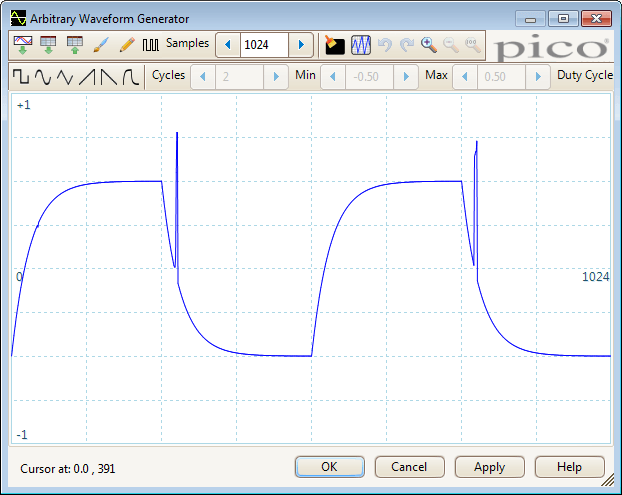Review: PicoScope 2208B-MSO USB Oscilloscope
AWG
The arbitrary waveform generator (AWG) incorporated in the 2208B MSO is a delightful tool to use. In my case, I used it to “build” a copy of a very troublesome and at the same time volatile signal in one of my repair projects. This “playing hard to get” signal with its sudden spikes on the falling slope I was able to draw almost free-style using the Picoscope AWG software. Once saved and named "nasty" I made the 2208B’s AWG output feed the spike-infested signal to a prototype construction of the circuit on repair (okay, okay, it was a Tektronix tubed HV oscillator, self-oscilalting and producing –1600 volts). Further analysis revealed a faulty capacitor in the (low-voltage) frequency control loop, and a triode tube suffering fom grid leakage. Fixed. Thanks Pico!
MSO and Serial Decoder
So far I have failed to grasp how the term MSO for “mixed signal oscilloscope” came about. An MSO they say is the combination of a digital oscilloscope and a logic analyzer. Why the signal formats are said to be ‘mixed’ is beyond me. Is it hybrid, i.e. analog/digital? For sure, there was a time when even an analog CRT scope was able to display, say, 8 traces of digital serial signals — not too fast of course, and assuming the CRT has sufficient write speed.The 2208B MSO has a powerful 16-channel logic analyzer, which I was unable to test for this quick review, but should be beyond reproach given Pico’s reputation. A total of 20 probe clips of the hook-on type are supplied, 16 red ones (data) and 4 black (ground). These connect to a 20-way cable terminated with a polarized IDC connector to link to the 2208B MSO instrument. Wires in the cable are numbered D0-D15 and GND (4x) for correlation to the 16 traces that appear in the signal window.
Conclusion
Many stories have been written on the pros and cons of USB oscilloscopes as opposed to their stand-alone counterparts with either a CRT (now old hat) or an LCD or LED display. I will not add to the discussion other than saying that a USB oscilloscope is a great choice if you are not bothered by the constant presence of a computer on your workbench. But then, just about any laptop you have is likely to have a much bigger viewing area and higher resolution than a typical benchtop scope. Also, with a USB oscilloscope you have instant access to the waveforms appearing on the screen — no file exporting or storage media like USB sticks required.Using the scope and the built in AWG it took me one afternoon to pinpoint and document a bad fault in a Sony audio amplifier. I realize that a digital scope, an arbitrary wave generator and a laptop PC is overkill for a basic signal tracing operation but the fact that everything is connected and instantly accessible right up to the Sony schematic on the Internet does have its advantages over wielding many separate instruments.
Although unable to exploit all features of the Picoscope 2208B MSO in this quick review, using the instrument has been an absolute delight. It has a steep learning curve and is tolerant of setting errors, with the Auto Setup function always available to get you out of a pickle. A few points bothered me though, but these are related to using a USB scope in general rather than this fine specimen from St. Neotts, Cambs. First, you need to be duly aware of the ±20 V spec on the instrument's inputs, that’s much lower than on most benchtop scopes. I know, the probes are rated 600 V DC but still. Also, I’d recommend using a dedicated PC or laptop for use in your workspace only. These things can be picked up cheaply and shpoid reduce input overload anxiety to some extent. Pico has no hassles with their scope software being migrated to another computer, licenses running out, or hard disks crashing. No such thing -- the software is free and updatable anywhere, anytime, free.
I was happy to see that the PicoScope is not a black box in the worst sense of the word. Okay it’s not open source or anything but the drivers and software development kit supplied allow you to write your own software or interface to popular third-party software packages such as LabVIEW.
Finally, as a suggestion from a self-educated repairman, can we have an audio listen-in feature added? Should be easy using USB and the computer’s sound card.
A selection of 2200 series PicoScope is available from the Elektor Store.
Read full article
Hide full article

About Jan Buiting
Jan Buiting (1958) has been active in electronics and ways of expressing it since the age of 15. Attempts at educating Jan formally have so far yielded an F-class radio amateur license, an MA degree in English, a Tek Guru award, and various certificates in ele... >>



Discussion (0 comments)